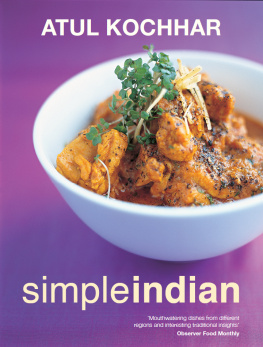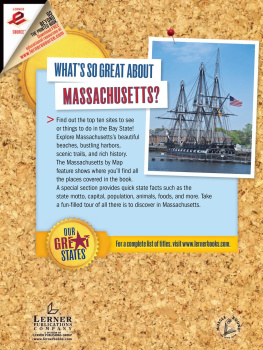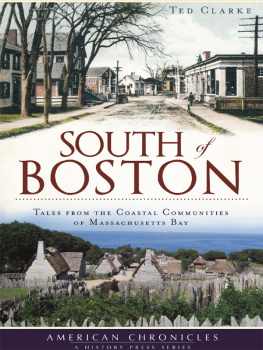



Published by The History Press
Charleston, SC
www.historypress.com
Copyright 2018 by Meenal Atul Pandya
All rights reserved
Frontispiece: This sketch of the Mayflower II (pen, ink and charcoal) was made by Matcheri S. Keshavan at the Pilgrim State Memorial Park (Plymouth, Massachusetts). Dr. Keshavan, a physician and professor of psychiatry at Harvard Medical School, lives in Massachusetts.
First published 2018
e-book edition 2018
ISBN 978.1.43966.448.3
Library of Congress Control Number: 2018932121
print edition ISBN 978.1.62585.944.0
Notice: The information in this book is true and complete to the best of our knowledge. It is offered without guarantee on the part of the author or The History Press. The author and The History Press disclaim all liability in connection with the use of this book.
All rights reserved. No part of this book may be reproduced or transmitted in any form whatsoever without prior written permission from the publisher except in the case of brief quotations embodied in critical articles and reviews.
Dedicated to future generations of Indian Americans
CONTENTS
PROLOGUE
When I first came to the United States in 1976, there were fewer than 100,000 Indians scattered across the entire country. Running into another Indian, be it in the grocery store, shopping mall or university, often turned into the beginning of a lifelong friendship. It was a special time in the story of Indian immigration to the United States, a story that had only just begun to unfold in the mid-60s, a story that has now touched millions of lives in the United States and India.
As part of the first wave of Indian immigrants to arrive in the United States, I have witnessed and lived the story that is described in these pages. In many ways, my personal journey mirrors that of the Indian American diaspora. I vividly remember the joy I felt when I stepped foot in the first Indian grocery store in Massachusetts to buy spices. Every Sunday for many years, I woke up to Bollywood music aired by Sounds of India, Massachusettss first Indian radio program. And I remember the opening prayers at Sri Lakshmi Temple in Ashland, the first Hindu temple in the state.
Even during those early days, I had an inkling that I was witnessing history in the making. Over the decades, that feeling grew stronger as I noticed how the Indian American community was evolving and, as a result, influencing both India and America. I felt that this story needed to be documented for the current as well as future generations.
My hope is that this book will serve as a benchmark for future generations to learn how and why early immigrants from India came to Massachusetts and how they made their home halfway around the globe. As you read this, please keep in mind that this is a live document, a snapshot in time. As a firsthand narration of a contemporary immigrant history, this book has a few advantages. First, being part of the community, I have had a pulse on the dynamics of the community. I have tried to tell the stories of Indian American pioneers through their own words as much as possible. I have spoken to close to one hundred Indian Americans in Massachusetts who represent the different waves of Indian immigration, the diversity of India and many different vocations and avocations. I have selected these individuals because they have not only excelled in their chosen fields but have also contributed in many different ways to the growth of the larger community. They are doctors and technocrats, entrepreneurs and housewives, scientists and media personalities, bankers and community activists who have opened their homes and hearts to me. For that, I am thankful to each of them.
I want to stress a couple of points before you start reading this book. The flip side of the advantages of a firsthand account is that there are some pitfalls that come hand-in-hand. As a member of the very community I am writing about, my proximity to the subject matter inherently lends itself to some bias; I have tried my best to be aware of and correct for this bias. I have reached out to individuals of all backgrounds to make sure the picture of the community depicted in these chapters accurately represents the diversity of the Indian American community in Massachusetts. Nevertheless, although I have talked to many individuals in the community, I know that there are many more whose stories could have been included here. It was not practically possible to include them all, and what you read here is an illustrative sample of the larger Indian American community. Similarly, there are many Indian organizations strengthening the community, but it was impossible to list them all and their various activities. I have selected organizations that I believe have been pioneers, have played an instrumental role in the establishment of the community or are representative of the larger community as a whole.
The process of writing this book has been rewarding and inspiring for me. It has allowed me to meet many remarkable people who are at the forefront of innovation in their respective fields, making commendable contributions. Their zeal and positive energy have made me very optimistic about the future of the Indian American community. This process has also opened my eyes to dimensions of the Indian American experiences that were previously unknown to me. My hope is that you, the reader, will also find this book similarly illuminating.
Lastly, I want to emphasize that the history of Indians in America is dynamic and still evolving. What made writing this book interesting and engaging was that it is a live history that is still being written. The anecdotes in these pages are the firsthand accounts of pioneers of the community. Think of this book as a community memoir rather than a historical document.
ACKNOWLEDGEMENTS
Writing about Indian immigrants in America is a challenging tasknot just because it is history in the making or because there is very little written about them (though both of these reasons are true) but because there are as many narratives as there are Indian immigrants. Their stories depend on so many factors: which era they arrived in America, whether they came from a metropolitan city or rural village in India, at what age they came, their personal circumstances and many more. This book is an attempt to capture their journey, their achievements, their struggles and their contributions. In the process of writing this book, I have taken the help of many people, to whom I am greatly indebted for taking time out from their busy professional careers and family needs. They have contributed by opening their hearts and their homes and sharing their personal journeys with me. I have spoken to close to one hundred different individuals, including very busy doctors and entrepreneurs to young mothers and students. It is impossible to name them all, but I would like to especially thank a few who have contributed to this endeavor significantly and have gone out of their way to connect me with others. First and foremost is Dr. Dinesh Patel, who provided his unrelenting help and suggestions. Dineshbhai, your assistance was invaluable in the writing of this book. Nishith Acharya, despite a very busy life with thriving career, a young family, ongoing travel and work, helped me by offering his insights about the community. He also put me in touch with many others who contributed to this book. Raj Sharma invited me into his home, where I met his extended family, who each shared their personal journeys. Thank you, Raj. Many busy community activists, leaders and entrepreneurs took time from their lives to sit with me to recount their early experiences. Thank you to Dr. Desh and Jaishree Deshpande, Harish Dang, Dr. Krishnamoorthy Subbu, Dr. Balram Singh, Narain Bhatia, Ramesh Kapur, Ranjani Saigal, Dr. Mahesh Mehta, Sanjay Kaul, Upendra Mishra, Neena Gulati, Sushil Tuli, Adi Gazdar, Dr. Sangeeta Bhatia, Vasant Jinwala, Taniya Nayak, Ashish Cowlagi, Dr. Pradeep Shukla, Preetesh Shrivastava and many more. Preetesh, you were great to respond to my request during one of your most busy weekends. Thank you. Special thanks to Dr. Anil and Binduben Shah and their family for sharing the experiences of Bindubens father, Trikamlal Shah, who came to study at MIT in 1927. Thank you, Dr. Keshavan, for your beautiful artwork that graces this book. I am grateful to Peabody Essex Museum for sharing its pictures and information that has enriched this book significantly. Organizations like India Society of Worcester, India New England News, India Association of Greater Boston and Vishwa Hindu Parishad of America offered their information and history to share. Thanks to the leaders of these organizations. I am indebted to my friend Betsy Zahniser, who edited my manuscript and gave me many helpful suggestions, along with her unwavering support. Thank you, Betsy.









![Madhav Deshpande - Critical Studies in Indian Grammarians I: The Theory of Homogeneity [Sāvarṇya]](/uploads/posts/book/255206/thumbs/madhav-deshpande-critical-studies-in-indian.jpg)




